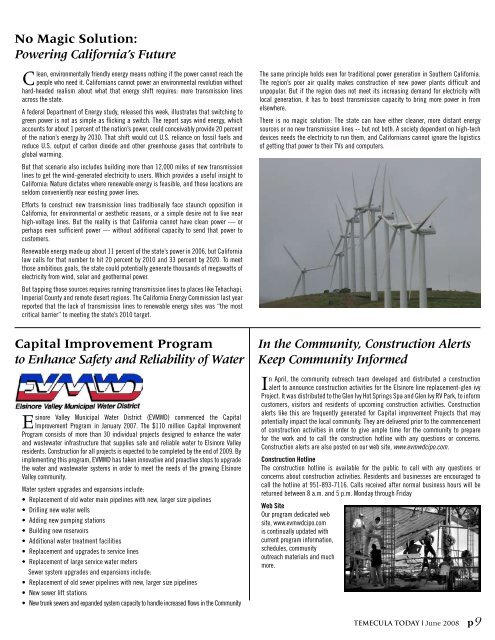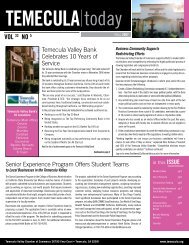FODECLOSUDE CITy NEWS - Temecula Valley Chamber of ...
FODECLOSUDE CITy NEWS - Temecula Valley Chamber of ...
FODECLOSUDE CITy NEWS - Temecula Valley Chamber of ...
You also want an ePaper? Increase the reach of your titles
YUMPU automatically turns print PDFs into web optimized ePapers that Google loves.
no Magic Solution:<br />
Powering California’s Future<br />
Clean, environmentally friendly energy means nothing if the power cannot reach the<br />
people who need it. Californians cannot power an environmental revolution without<br />
hard-headed realism about what that energy shift requires: more transmission lines<br />
across the state.<br />
A federal Department <strong>of</strong> Energy study, released this week, illustrates that switching to<br />
green power is not as simple as flicking a switch. The report says wind energy, which<br />
accounts for about 1 percent <strong>of</strong> the nation’s power, could conceivably provide 20 percent<br />
<strong>of</strong> the nation’s energy by 2030. That shift would cut U.S. reliance on fossil fuels and<br />
reduce U.S. output <strong>of</strong> carbon dioxide and other greenhouse gases that contribute to<br />
global warming.<br />
But that scenario also includes building more than 12,000 miles <strong>of</strong> new transmission<br />
lines to get the wind-generated electricity to users. Which provides a useful insight to<br />
California: Nature dictates where renewable energy is feasible, and those locations are<br />
seldom conveniently near existing power lines.<br />
Efforts to construct new transmission lines traditionally face staunch opposition in<br />
California, for environmental or aesthetic reasons, or a simple desire not to live near<br />
high-voltage lines. But the reality is that California cannot have clean power — or<br />
perhaps even sufficient power — without additional capacity to send that power to<br />
customers.<br />
Renewable energy made up about 11 percent <strong>of</strong> the state’s power in 2006, but California<br />
law calls for that number to hit 20 percent by 2010 and 33 percent by 2020. To meet<br />
those ambitious goals, the state could potentially generate thousands <strong>of</strong> megawatts <strong>of</strong><br />
electricity from wind, solar and geothermal power.<br />
But tapping those sources requires running transmission lines to places like Tehachapi,<br />
Imperial County and remote desert regions. The California Energy Commission last year<br />
reported that the lack <strong>of</strong> transmission lines to renewable energy sites was “the most<br />
critical barrier” to meeting the state’s 2010 target.<br />
Capital Improvement Program<br />
to Enhance Safety and Reliability <strong>of</strong> Water<br />
Esinore <strong>Valley</strong> Municipal Water District (EVMWD) commenced the Capital<br />
Improvement Program in January 2007. The $110 million Capital Improvement<br />
Program consists <strong>of</strong> more than 30 individual projects designed to enhance the water<br />
and wastewater infrastructure that supplies safe and reliable water to Elsinore <strong>Valley</strong><br />
residents. Construction for all projects is expected to be completed by the end <strong>of</strong> 2009. By<br />
implementing this program, EVMWD has taken innovative and proactive steps to upgrade<br />
the water and wastewater systems in order to meet the needs <strong>of</strong> the growing Elsinore<br />
<strong>Valley</strong> community.<br />
Water system upgrades and expansions include:<br />
• Replacement <strong>of</strong> old water main pipelines with new, larger size pipelines<br />
• Drilling new water wells<br />
• Adding new pumping stations<br />
• Building new reservoirs<br />
• Additional water treatment facilities<br />
• Replacement and upgrades to service lines<br />
• Replacement <strong>of</strong> large service water meters<br />
Sewer system upgrades and expansions include:<br />
• Replacement <strong>of</strong> old sewer pipelines with new, larger size pipelines<br />
• New sewer lift stations<br />
• New trunk sewers and expanded system capacity to handle increased flows in the Community<br />
The same principle holds even for traditional power generation in Southern California.<br />
The region’s poor air quality makes construction <strong>of</strong> new power plants difficult and<br />
unpopular. But if the region does not meet its increasing demand for electricity with<br />
local generation, it has to boost transmission capacity to bring more power in from<br />
elsewhere.<br />
There is no magic solution: The state can have either cleaner, more distant energy<br />
sources or no new transmission lines -- but not both. A society dependent on high-tech<br />
devices needs the electricity to run them, and Californians cannot ignore the logistics<br />
<strong>of</strong> getting that power to their TVs and computers.<br />
In the Community, Construction Alerts<br />
Keep Community Informed<br />
In April, the community outreach team developed and distributed a construction<br />
alert to announce construction activities for the Elsinore line replacement-glen ivy<br />
Project. It was distributed to the Glen Ivy Hot Springs Spa and Glen Ivy RV Park, to inform<br />
customers, visitors and residents <strong>of</strong> upcoming construction activities. Construction<br />
alerts like this are frequently generated for Capital improvement Projects that may<br />
potentially impact the local community. They are delivered prior to the commencement<br />
<strong>of</strong> construction activities in order to give ample time for the community to prepare<br />
for the work and to call the construction hotline with any questions or concerns.<br />
Construction alerts are also posted on our web site, www.evmwdcipo.com.<br />
Construction Hotline<br />
The construction hotline is available for the public to call with any questions or<br />
concerns about construction activities. Residents and businesses are encouraged to<br />
call the hotline at 951-893-7116. Calls received after normal business hours will be<br />
returned between 8 a.m. and 5 p.m. Monday through Friday<br />
Web Site<br />
Our program dedicated web<br />
site, www.evmwdcipo.com<br />
is continually updated with<br />
current program information,<br />
schedules, community<br />
outreach materials and much<br />
more.<br />
<strong>Temecula</strong> Today | June 2008 p9







